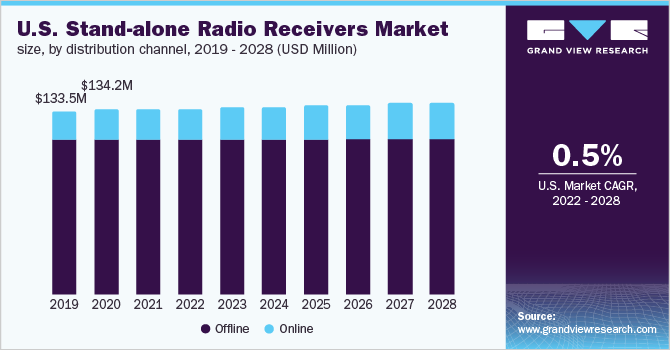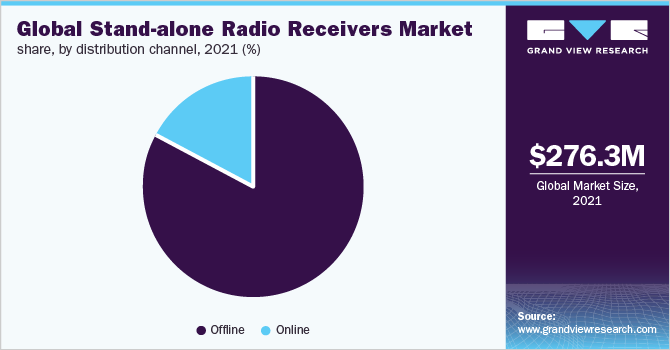
Stand-Alone Radio Receivers Market Size, Share & Trend Analysis Report, By Distribution Channel (Offline, Online), By Region, And Segment Forecasts, 2022 - 2028
- Report ID: GVR-4-68039-938-2
- Number of Report Pages: 74
- Format: PDF
- Historical Range: 2017 - 2020
- Forecast Period: 2022 - 2028
- Industry: Consumer Goods
Report Overview
The global stand-alone radio receivers market size was valued at USD 276.3 million in 2021 and is expected to expand at a compound annual growth rate (CAGR) of 1.2% from 2022 to 2028. This can be credited to the rising demand for stand-alone radio receivers from developing regions such as the Asia Pacific. The rising development in technologies to furnish consumer demands is expected to generate market opportunities over the coming years.

Constant investments by major market players in research and design for the development of new devices with superior features are likely to propel the industry growth of stand-alone radio receivers. Additionally, key players are focusing on developing easy-to-use and high-performing devices due to steady demand from the consumer side.
Owing to the COVID-19 pandemic, the demand for the market has been affected. New projects all over the world have been delayed, which resulted in a decline in demand for stand-alone radio receivers from end-users. Global factories have faced difficulties to integrate new stand-alone radio receivers as workers have stayed in their homes, which disrupted the global supply chains. The COVID-19 lockdowns are expected to help companies think about more advanced stand-alone radio receivers to enhance efficiency.
The supportive government initiatives for the consumer electronics industry is anticipated to promote the growth of the market. Initiatives such as green buildings that support energy-efficient radio receiver devices are projected to drive the growth of this market. Also, various initiatives regarding the development of energy-efficient devices and increasing manufacturing capacity are anticipated to result in a rise in the demand for radio receiver products. All these factors are expected to drive positive growth in this market in the coming years.
The rising investments by market players to launch new devices are further projected to drive the industry sales. However, the availability of counterfeit products and the lesser lifecycle of products may challenge the progression of the market. Also, rising consumer adoption of new products incorporated with the latest technologies owing to rapid changes in the consumer technology field may hamper the growth of this market.
The main drivers that have augmented the stand-alone radio receiver market development are the rise in next-generation wireless networks, the growth in mobile communication equipment, and an increase in data traffic. The concept of carrier aggregation, a rise in silicon on insulator technology, an increase in usage of internet services, and declining prices of mobile handsets are expected to fuel the growth of the stand-alone radio receiver market.
The growing trend of miniaturization in electronic devices is also propelling the demand for the stand-alone radio receiver industry globally. The growing number of applications such as home automation, smart grids, and medical implants that use stand-alone radio receivers are also propelling the market growth. In terms of value, the U.S. constitutes the largest market for imported stand-alone radio receivers in 2021. Driven by the rising demand for stand-alone radio receivers globally, the market is anticipated to witness an increasing usage trend during the forecast period.
Distribution Channel Insights
The offline distribution channel segment accounted for the highest share of over 83% of the global market revenue in 2021. This includes hypermarkets, conventional stores, specialty stores, supermarkets, independent retail stores, etc. The mounting organized retail sector in developing economies such as China, Malaysia, and Japan is anticipated to augment the demand for stand-alone radio receiver products in the coming years. In addition, it offers a choice of physical confirmation as well as a trial facility for products to the customer. Thus, the offline segment contributes more to the market revenue.

The online segment will register the highest growth during the forecast period in the stand-alone radio receivers market, due to its growing usage among the population. Customers have started buying products online due to the simplicity and convenience provided by this channel. Products are available at economic rates via online channels, when compared to offline. The upsurge in the sales of stand-alone radio receiver products, mainly through e-commerce companies such as Walmart, Amazon, and company-owned websites, is likely to drive the development of this channel in the coming years.
Online stores have a wide scope of choices accessible. There is no limit to the plans, materials, price, and styles, which makes the shopping experience a lot easier and better. The increasing inclination toward the internet and smart devices will further boost industry sales.
Regional Insights
North America held the majority of the industry share of over 60% in 2021, owing to the high radio reach into the regional population. Over half of the world’s radio receiver product revenue is generated from North America, as a majority of radio listeners are present here. Furthermore, a steady sale of stand-alone radio receiver products is propelling the growth of this market in this region. A high concentration of working people, coupled with higher disposable income in Canada and the U.S., is further anticipated to fuel the regional growth.
Asia Pacific is expected to witness a CAGR of 2.6% from 2022 to 2028. This can be attributed to the growing demand for stand-alone radio receiver products in this region. Additionally, the increasing population and rising disposable income in this region are driving the growth of this market. The growing demand for energy-efficient radio receiver products is also estimated to propel the market growth during the forecast period.
Asia Pacific is expected to witness lucrative growth during the projection period, due to the rising instances of government initiatives about the implementation of Radio Frequency Identification (RFID) technologies across various industries within countries like China and India.
Key Companies & Market Share Insights
Market players are focusing on extensive R&D and launching energy-efficient products to meet the increasing demand. Key players are investing in acquisitions and mergers to increase their production capacity along with market expansion. These activities have created a way for the development of the business as well as the customer base of companies operating in the market. The industry players in the market for stand-alone radio receivers are expected to provide ample development opportunities during the forecast period. Major companies operating in the global stand-alone radio receivers market are as follows:
-
Sony
-
Panasonic
-
Philips
-
Bose
-
Roberts Radio
-
Tivoli Audio
-
Ruark Audio
Stand-Alone Radio Receivers Market Report Scope
|
Report Attribute |
Details |
|
Market size value in 2022 |
USD 279.49 million |
|
Revenue forecast in 2028 |
USD 300.51 million |
|
Growth Rate |
CAGR of 1.2% from 2022 to 2028 |
|
Base year for estimation |
2021 |
|
Historical data |
2017 - 2020 |
|
Forecast period |
2022 - 2028 |
|
Quantitative units |
Revenue in USD Million/Billion and CAGR from 2022 to 2028 |
|
Report coverage |
Revenue forecast, company ranking, competitive landscape, growth factors, and trends |
|
Segments covered |
Distribution channel, region |
|
Regional scope |
North America; Europe; Asia Pacific; Central & South America; Middle East & Africa |
|
Country scope |
U.S.; Germany; U.K.; France; China; Japan; South Africa; Brazil |
|
Key companies profiled |
Sony; Panasonic; Philips; Bose; Roberts Radio; Tivoli Audio; Ruark Audio |
|
Customization scope |
Free report customization (equivalent up to 8 analysts’ working days) with purchase. Addition or alteration to country, regional & segment scope. |
|
Pricing and purchase options |
Avail customized purchase options to meet your exact research needs. Explore purchase options |
Segments Covered in the Report
This report forecasts revenue growth at global, regional & country levels and provides an analysis of the latest industry trends and opportunities in each of the sub-segments from 2017 to 2028. For the purpose of this study, Grand View Research has segmented the global stand-alone radio receivers market report on the basis of distribution channel and region:
-
Distribution Channel Outlook (Revenue, USD Million, 2017 - 2028)
-
Offline
-
Online
-
-
Regional Outlook (Revenue, USD Million, 2017 - 2028)
-
North America
-
U.S.
-
-
Europe
-
Germany
-
U.K.
-
France
-
-
Asia Pacific
-
China
-
Japan
-
-
Central & South America
-
Brazil
-
-
Middle East & Africa
-
South Africa
-
-
Frequently Asked Questions About This Report
b. The global stand-alone radio receivers market size was estimated at USD 276.25 million in 2021 and is expected to reach USD 279.49 million in 2022.
b. The global stand-alone radio receivers market is expected to grow at a compound annual growth rate of 1.2% from 2022 to 2028 to reach USD 300.51 million by 2028.
b. North America dominated the stand-alone radio receivers market with a share of 60.3% in 2021. This is attributable to constant investments by major key players in research and design for the development of new devices with superior features.
b. Some key players operating in the stand-alone radio receivers market include Sony; Panasonic; Philips; Bose; Roberts Radio; Tivoli Audio; and Ruark Audio.
b. Key factors that are driving the stand-alone radio receivers market growth include supportive government initiatives for consumer electronics along with rising consumer adoption of new products incorporated with the latest technologies.
We are committed towards customer satisfaction, and quality service.
"The quality of research they have done for us has been excellent."




